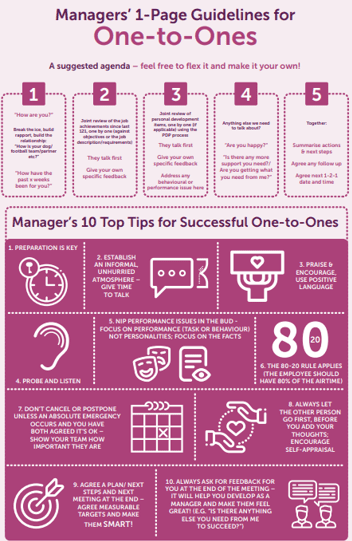We All Have Them But are Your One-To-One Meetings Effective?
Company growth is hugely dependent on the quality of people in the workforce. Each individual’s abilities and potential matter to the role they’ve assumed for the company. But teamwork, collaboration, and the depth of employee-manager relationships significantly influence the company performance and overall longevity. Insert one-to-one meetings here.
It’s challenging to find reliable literature on how managers should approach one-on-one meetings. This is because their effectiveness is subject to opinion, industry, and overall dependant on the type of relationship the manager has with their employee.
However, the recent shift towards remote work has highlighted the need for better communication among managers and employees all around, as dynamics shifted drastically in the workplace. Improved use of one-to-one meetings is an opportunity to address those communication issues and better relationships throughout your company.
Why are One-to-One Meetings Valuable?
Often, one-to-one meetings are the first thing canceled or rescheduled when a busy week hits us. But, these meetings should be the last thing you think about postponing because of how powerful they can be in developing a trust-filled manager-employee relationship.
The purpose of a one-on-one meeting is to dedicate time to learn important information about your employees, provide support to them, let them know where they stand in their productivity and quality of work, and offer guidance for growth. The value of one-on-one meetings with your team members is in the opportunity to provide them with valuable feedback, intentional coaching, a personal relationship, and a work environment suitable for personal and professional development.
Other Advantages of One-to-One Meetings Include:
- Managers and employees are more inspired, motivated, and comfortable bringing up challenging issues.
- Employees have better productivity and a renewed sense of purpose in their roles.
- Credibility is built between managers and employees.
- Employees can begin trusting senior leadership through intimate and reliable relationships.
- They improve communication among employees and between you and your employees.
- They help employees overcome professional and personal challenges.
When an employee trusts you, they’re more likely to perform at a high level and follow your lead. The best way to build trust is to get to know your employees personally and take an interest in their progression. One-on-one meetings will help you build a solid foundation for trust-filled relationships.
Six Steps to an Effective One-to-One Meeting
Managers have an incredible workload all on their own. They also have the added responsibility of managing each team member’s workload and ensuring they’re performing at their highest level. Effective one-to-one meetings ensure you’re wholly supporting your employees’ professional and emotional wellbeing. For the high-resolution infographic, click on the image below:

Here are six steps to hosting an effective one-to-one meeting:
1. Send a Questionnaire or Email Asking for Information Beforehand
Once you’ve scheduled a one-to-one meeting with an employee, you need to start preparing for the meeting. Consider preparing ahead of time through a questionnaire or email asking for information beforehand that you think would aid a productive discussion. Especially if this is the first one-to-one meeting you’ve had with this particular employee.
Consider the following talking points when preparing for your one-to-one:
- Which was their biggest challenge this week?
- What was their greatest success this week?
- Are they dissatisfied with anything in their current role?
- What does a productive one-on-one meeting look like for them?
- How you can help them open up in this setting?
- Any questions or concerns they have?
2. Prepare a Shared Agenda for your Meeting
After receiving the relevant information and feedback from your questionnaire or email, prepare an agenda for your meeting. Show up with potential solutions to expressed challenges, feedback on their concerns, and questions that will help you get to know them on a deeper level. You should also note any behavioral changes or signs of conflict with other employees that should be addressed in this meeting.
Start your meeting agenda with a positive. Share your appreciation of your employee’s work by highlighting a recent milestone or achievement. This starts the meeting off with the right energy and makes it easier to express any concerns you have later on. The rest of your meeting agenda should be filled with helpful questions, feedback, and suggestions for moving forward. While also ensuring the employee has a chance to speak candidly and openly.
Further, this should not be seen as a time to speak at them, but rather, in collaboration with them. Ensure they feel like an equal part of the conversation. According to Maryville University, “Many managers tend to lean more toward collaborative leadership styles, such as an affiliative or participative leadership, in which managers and employees work together as a team.” Depending on your industry and the kind of workplace culture you’re cultivating, this type of leadership style may be the most successful in regard to earning your employees’ trust and respect during one-to-one sessions and beyond.

3. Give your Undivided Attention to the Meeting
Respect and value your employee’s time by actively listening and fully engaging in the session.
Take notes during the meeting and encourage your employees to do the same. Don’t spend the entire session talking about work, either. The heart of your conversation should be getting to know your employees personally so that you can better support them through all of what they’re going through. Even if that includes learning about their pets at home, what they do to decompress after work, upcoming vacation plans, and more.
Some questions you can ask to inspire conversation in an effective one-to-one meeting include:
- How are you feeling this week?
- How can I support you to be able to face these challenges head-on?
- Are you having any issues with coworkers or management you’d like to discuss?
- What does your dream career entail?
- What’s your life vision?
- How can your role here help you achieve your vision?
- What do you like to do outside of work?
- Are you taking care of yourself off the clock?
- Do you feel like you know all of the resources available to you here?
- Can we put together a plan to move you forward?
- Do you feel supported?
4. Prepare an Actionable Plan for Moving Forward
You don’t want to end a meeting without a plan for moving forward. Create an actionable plan based on what you talked about in the meeting. Take a moment to review the notes you’ve taken and pinpoint one or two things you’re employee would like to make progress on. Additionally, you might even consider sending a follow-up email or message to outline the things you’re going to follow up on. Either with them or with another member of staff that the employee had a concern about.
If one of their goals is hitting a sales goal, identify steps they can take to get closer to that goal. These steps could be having a conversation about a product or service with a set amount of customers each day. Alternatively, if the goal is improving the employee’s ability to meet deadlines, set up real consequences for the employee if they don’t meet the goal and awards for when they do. No matter what it is, following up regularly and with positivity is going to ensure a strong relationship between you and the employee.
5. Schedule the Next One-to-One Meeting
Having regular one-to-one meetings is vital to their effectiveness. If you go weeks or months without a meeting, it affects how well employees take to them. Practice consistency by scheduling the next one-to-one meeting before ending the current one.
One-to-one meetings should be scheduled at least once a month, but weekly meetings seem to be the most effective because it gets employees in the habit of sharing. Also, frequent meetings give managers more opportunities to improve their employees’ overall productivity and boost their performance. Because it makes it easier to have a finger on the pulse of the employee’s day to day without a lot of time passing in between. Ensure that you and your employee have the next one-on-one meeting on the books before stepping out of the office.

6. Check-in on the Progress with the Established Plan
Until the next meeting, you should be checking on the progress an employee is making on the previous meeting plan. Whether it’s sales goals, a mental health improvement plan, or a strategy to support them through a particularly challenging project, you want to check if what you planned is actually happening.
Checking in on progress regularly shows your employees that you were engaged in the meeting and are committed to supporting them fully. Whilst building credibility and trust in the relationship.
Start Utilising One-to-One Meetings Today
One-to-one meetings are valuable in any industry, for any company culture. You can begin implementing one-on-one meetings by first hosting a team meeting expressing your intent to hold individual meetings with them weekly or monthly. Also, let them know why you want to have these meetings and encourage feedback on implementing this change. Hosting this initial meeting will allow employees to prepare for the change adequately.
Our workforces look different today, because of the COVID-19 pandemic. Many companies had to move their operations online and are partaking in remote work. Therefore, it can be challenging to hold one-to-one meetings remotely and have the same level of effort, accountability, and collaboration presented in a face-to-face setting. But after ensuring you’re set up with the right communication tools, you should have no problem hosting successful one-on-one sessions after a little bit of getting used to it. Use tools like Zoom, Slack, Asana, and Google hangout to get the best results in a virtual meeting.
Meaningful one-to-one meetings will positively impact you, your employees, and your attempt to build a solid company culture. Start small, focus on collaboration and inspiring conversation, and take it from there.




